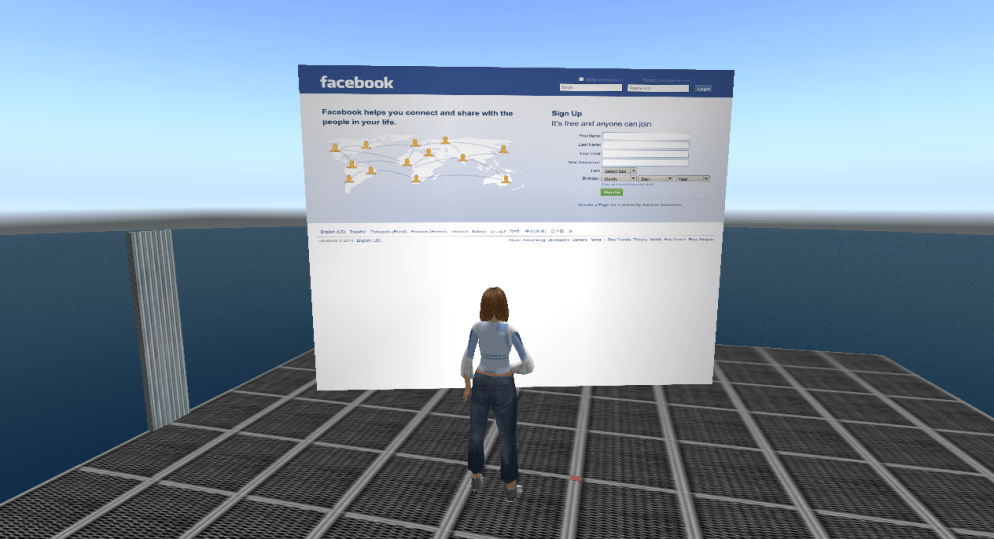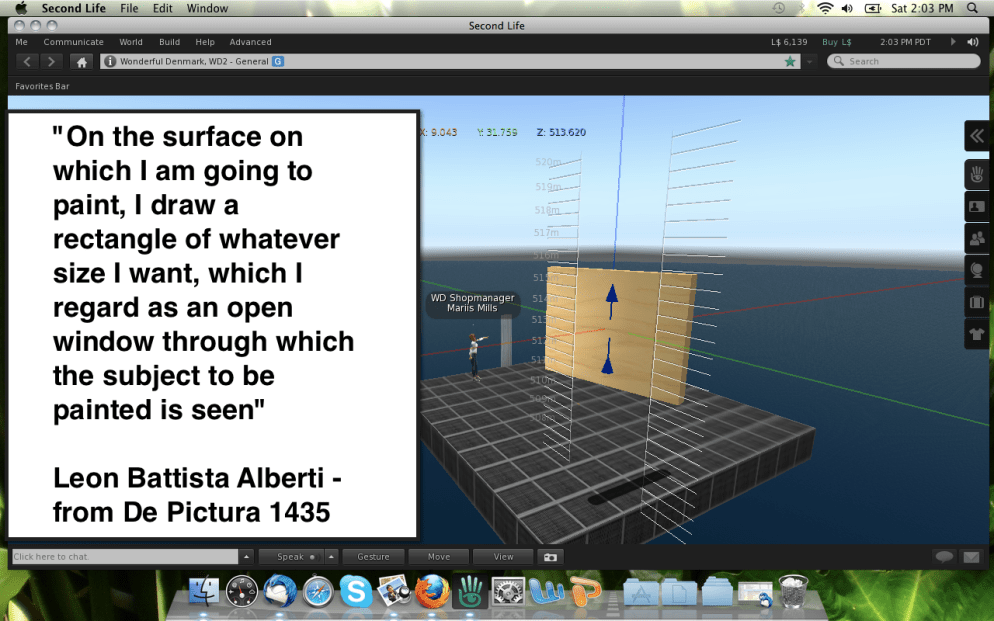Based on the above quote the “Alberti window” is frequently used as a metaphor to describe the sense of immediacy, and for some immersion, that users experience in especially virtual reality and virtual worlds as it points to the idea that it is possible – at least in a psychological sense – to “step through” the window and enter the space depicted. Here I’ve taken the quote from Bolter & Grusin’s book “Remediation – Understanding New Media” p. 24-25. As part of my research on remediation I’ve spent the last couple of days studying their book in detail and this post will be the first in a series of trying to make sense of my notes combined with my experience in and examples from SL. But before getting to the point I wanted to make about Alberti’s window and the new shared media function in SL, let me just make some quick remarks on some of the key concepts in the book.
In the glossary Bolter & Grusin explain remediation this way:
Defined by Paul Levenson as the “anthropotropic” process by which new media technologies improve upon or remedy prior technologies. We define the term differently, using it to mean the formal logic by which new media refashion prior media forms.
Bolter & Grusin. 1999:273
Throughout the book Bolter & Grusin continue to elaborate on the concept, and an apparent distinction from Levenson’s definition is that they see remediation as a process that also can go the reverse way, meaning that older media also can remediate new media – i.e. Television incorporating social media like Twitter streams or text-message polls via cellular phones in live shows to enhance interactivity. Another important point for Bolter & Grusin is that there are a number of ways in which especially digital media remediate their predecessor – a spectrum that goes from respectful to radical remediation (ibid. p. 200). These ways can be divided into two main strategies depending on their foundational logic, something Bolter & Grusin call the Double logic of Remediation, which can be based primarily on
- either immediacy (aimed at diminishing the users awareness the medium/mediation)
- or hypermediacy (aimed at enhancing the users awareness of the medium/mediation)
It is, however, important to notice that the authors do not see these two forms of logic as contradicting, but rather as mutually dependent. According to Bolter & Grusin the underlying premise of all remediation is our “insatiable desire for immediacy” (ibid. p.5), which leads to the following paradox of the double logic:
Our culture wants both to multiply its media and to erase all traces of mediation: ideally it wants to erase its media in the very act of multiplying them. (ibid.p. 5)
Even though the book was conceived and published long before 3D virtual (and interactive!) media became mainstream (they do cover early “computer games”), I do find the concepts rather useful in explaining some of the phenomena I’ve experienced in SL. I agree that we strive for authenticity understood as quality in our interaction with new, digital media, and with the present changes in the SL viewer and most notably the shared media function, I think it is possible to give a contemporary example of the double logic paradox …
In short the SL Shared Media (SLSM) allows a wide range of web pages, including Flash and YouTube videos to be displayed on any surface of any prim (building block), among which some also allow for real time collaboration such as my student PerSecond and I previously demonstrated with Google docs and Etherpad. Now, in my context of Distance Education this new function offers many interesting possibilities. A major argument for me as a distance educator to research SL stems from this particular media’s ability to provide the user with a sense of being embodied in a palpable place – mainly in opposition to conventional teaching and learning platforms, where the user typically finds himself disembodied in impalpable space. In the pictures below I’m represented as my avatar standing on my holodeck looking at a shared media prim displaying Facebook.

Looking at Facebook via a window in SL

Interacting with Facebook via a window in SL
These pictures were deliberately taken from within SL, and they illustrate how I – literally by opening a window and “stepping through” it – am able to not only look at, but also interact with “the space depicted”, which in this case is the world outside SL. In doing so, it is my argument that I’ve been able to enhance the sense of immediacy through hypermediacy or to put it in other words: by multiplying the media I’ve been able to “erase” the sense of mediation in so far as interaction with the outside world can be regarded as a means to enhance the authenticity of my experience. But that’s not all. I’m able to add yet another dimension to my experience by changing my perspective as shown below:

By zooming out and taking a screen shot I’m able to show another reality of the experience; by watching myself as avatar looking and interacting in SL, I’m able to “step back or out of the window” and reflect on the experience from a meta perspective. This actually doesn’t depend on the SLSM function, but is one of the great affordances of SL as medium in general. There is, however, no doubt in my mind that the SLSM function via windows to the other worlds/parts of reality can contribute to the authenticity and quality of user experience in especially education and business, where our need for immediacy apparently is insatiable …
/Mariis

Love it.
This statement: “Television incorporating social media like Twitter streams or text-message polls via cellular phones in live shows to enhance interactivity.” reminded me that TIVO originally was envisioned itself doing this before it became a consumer product. Some even predicted it would be used to replace voting & that (which I believe can now happen with Dominoes pizza) you could order groceries through your TV. (Talk about couch potatoes!). My point is most of these ideas were passed aside. I think we are only on the cusp of these phenomena you discuss & a new innovation will incorporate all of them in ways we can’t imagine yet plus second & third order effects.
I couldn’t find examples but this also reminded me of those paintings/photos of infinite perspective where the artist shows a painting of a painting within the painting, ad infinitum ( though technically that is done through only the medium of photography/painting).
I agree Arielion – we will see media merge in ways we can’t image yet – think that’s also what Henry Jenkins means when he speaks of media convergence. The infinitum reminded me of this old SL favorite of mine – I have used it several times when teaching science theory to create a discussion on ontological issues ;-)
My head is spinning, Mariis. Wonderful post and such an interesting riff on Alberti and the concept of “windows”. I too have been completely taken by the power of the new SLSM function and what it hints at for the path ahead in education. To see (and interact with!) something recognizable/familar from the real world in the virtual world makes it so much more authentic – a huge qualitative lift. And when you add into the mix, the concept of multiple windows, nested windows, multiple images do we get hyperhypermediacy?
Yes, Spiral the multiplicity is very interesting – I’m not sure if Bolter & Grusin, would call it hyperhyper- or just hypermediacy. As much as I appreciate all these different re-mediations they also worry me in terms of complexity. It had me thinking of theories that include several loops or levels, Gregory Bateson.1972 “Steps to an Ecology of Mind” in particular. In his theory the level III is what I would characterize as meta, whereas the next level IV would be meta-meta – and he and his successors like Engestrom find that last level unrealistic, which I think has to do with complexity – there’s a limit to the distance from which we can still make sense of the world, I think. This also means that at a certain point hypermediacy ceases to facilitate immediacy … hmm, complex stuff ;-)